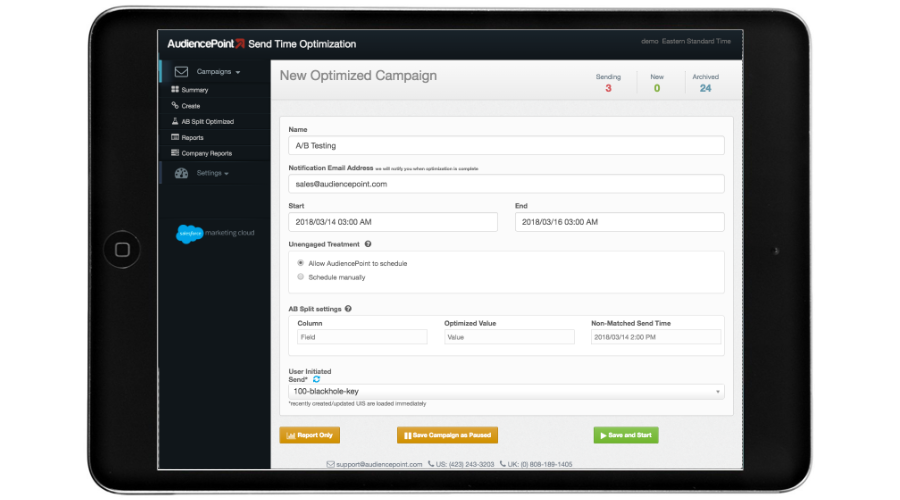AudiencePoint is thrilled to announce our new integration with Klaviyo! AudiencePoint is looking for partners to pilot our...
Is It Bad To Put Links In Emails?
The question of whether it’s bad to put links in emails often arises among email marketers eager to maintain high deliverability rates. Including links in email serves many purposes, from directing subscribers to landing pages to tracking the success of campaigns. However, without a strategic approach, links can deter deliverability and negatively affect inbox placement. Let’s explore the nuanced nature of links in email marketing and when they’re pertinent.
Pros and Cons of Including Links in Emails
Links in emails can be both beneficial and detrimental. On the positive side, they provide a channel for engagement beyond the confines of an email. They allow you to share additional resources, promote a product, or encourage actions such as registrations for events. For marketing professionals, this is invaluable for tracking user actions and evaluating campaign success.
On the downside, an excess of links can alarm spam filters, serve as a vector for phishing attempts, and confuse the audience. An email cluttered with links may be flagged as suspicious by spam filters, particularly if the links appear incongruent with the email’s content or if they redirect to unfamiliar domains.
Situations Where Links Are Appropriate
Links are appropriate when they complement the email’s main message and provide genuine value to the audience. For instance, including a ‘Read More’ link in a newsletter or a call-to-action button for a webinar signup gives your subscriber a clear and valuable pathway for interaction. It is crucial to ensure that every link serves a clear purpose and is formatted correctly to avoid triggering email signature spam alerts.
Impact of Excessive Linking on Email Deliverability
Excessive hyperlinking is a common red flag for email filters. When crafting emails, strive for moderation. Generally, it’s advisable to keep links to a minimum, often no more than two or three, to maintain a balance between informative content and promotional tactics. By judiciously selecting which links to include, marketers can reduce the risk of emails being marked as spam and thus optimize deliverability.
In conclusion, while links are a critical component of email marketing, their implementation needs to be mindful and deliberate. Careful consideration of link placement, relevance, and count can positively influence overall deliverability and ensure that your emails reach the intended audience.
Do Links Make Emails Go To Spam?
In the landscape of email marketing, understanding how links impact the deliverability of emails is crucial. It’s a common concern among marketers: Can an email with links be marked as spam? The answer, while nuanced, largely centers on how email spam filters operate and assess emails.
Role of Spam Filters in Email Linking
Spam filters employ sophisticated algorithms that assess several factors to determine whether an email should reach the inbox or be directed to the spam folder. While links themselves aren’t inherently bad, the way they’re used can trigger spam filters. For instance, emails overflowing with links, especially without personalized content or context, are often red-flagged as potential spam.
Factors Influencing Spam Classification
Several components determine how links influence spam classification. The reputation of the linked domains, the frequency of links within an email, and the presence of potentially malicious URLs are critically analyzed by spam filters. Low-reputation sites or shortened links, often used in phishing attempts, can damage deliverability. Therefore, it’s essential to link to reputable sources and use minimal links to minimize the risk of being flagged as spam.
How Many Links to Include to Circumvent Spam
While there’s no strict numerical limit, best practices suggest including only necessary and relevant links. A conservative approach often involves one or two links to enhance value without overwhelming the recipient. It’s also advisable to monitor email deliverability metrics regularly to determine if your strategy affects spam rates. By carefully curating the links in emails, you can mitigate the risk of your emails being misclassified as spam and enhance your email marketing campaigns’ overall effectiveness.
Does Link Tracking Affect Deliverability?
Understanding the Purpose of Link Tracking in Emails
Link tracking in emails is a strategic practice employed by email marketers to gauge the effectiveness of their campaigns. It enables businesses to measure metrics such as click-through rates, user engagement, and conversion rates. By tracking these interactions, marketers can gain deeper insights into what resonates with their audience, tailor future content to meet subscriber preferences, and ultimately drive improved engagement.
However, while link tracking provides valuable data, it must be implemented with caution. When performed correctly, it can significantly enhance an email marketing strategy, yet if mismanaged, it poses potential risks to your deliverability score.
Potential Downsides of Link Tracking
Using link tracking comes with certain drawbacks that could impact your email deliverability. One of the primary concerns is that certain tracking methods can trigger spam filters, especially if the tracked links appear suspicious to Internet Service Providers (ISPs). This is often due to the use of redirect URLs, which when overly complex or unfamiliar, might lead spam filters to block your emails.
Additionally, while link tracking can provide useful data, excessive use can overwhelm email servers and result in slower email delivery, further hampering deliverability rates. It’s crucial to strike a balance between collecting actionable data and maintaining high deliverability standards.
Best Practices for Using Tracked Links
To minimize the risks associated with link tracking, adhere to these email deliverability test best practices:
- Limit Redirections: Use direct and recognizable URLs whenever possible to reduce the suspicion from spam filters.
- Authenticate Your Emails: Ensure the authentication of your emails with SPF, DKIM, and DMARC to reinforce your sender reputation.
- Monitor Performance Regularly: Conduct regular deliverability tests to keep track of your emails’ performance metrics and make data-driven improvements.
By implementing these strategies, email marketers can effectively utilize link tracking to enhance their campaigns without compromising on deliverability.
What Hurts Email Deliverability?
Common Pitfalls Affecting Email Delivery
In the world of digital marketing, maintaining a high email deliverability rate is crucial for the success of your campaigns. However, several common pitfalls can hinder this goal. One of the most significant issues is sending emails to unverified or inactive addresses, which can increase your bounce rate and negatively impact your sender’s reputation. It’s essential to regularly clean your email list and ensure that it’s composed of engaged and valid subscribers.
Another common mistake is failing to adhere to email authentication protocols like SPF, DKIM, and DMARC, which verify the authenticity of your emails. Without these, your emails are more likely to be flagged as spam. Additionally, using spammy keywords in your subject lines or email content can trigger spam filters, preventing your emails from reaching inboxes.
Guidelines for Improving Email Deliverability
Improving your email deliverability requires a strategic approach incorporating best practices and avoiding common mistakes. Start by segmenting your email list to send targeted and relevant content to the right audience. This strategy ensures that your emails are opened, read, and acted upon.
Additionally, always keep your content engaging and concise, as this fosters higher engagement rates, which can boost deliverability. Providing clear and easy-to-find unsubscribe options can help maintain a positive relationship with your subscribers and minimize spam complaints. Regularly monitoring yur email performance metrics and using feedback to optimize your campaigns can significantly fix email deliverability.
Tools and Tests to Assess Email Deliverability
To ensure you’re on the right track, it’s beneficial to use dedicated tools to test and assess your email deliverability. These tools can offer deep insights into your current deliverability rates and provide recommendations for improvement. Additionally, running routine email deliverability tests can help identify any issues promptly, allowing you to take corrective action before they impact your campaigns.
Moreover, utilizing a platform like AudiencePoint can be a game-changer in this regard. With its advanced data tracking and analysis tools, AudiencePoint provides unparalleled insights into your email deliverability performance. By understanding how your subscribers interact with your messages and optimizing your sending practices accordingly, you can ensure that your campaigns are both effective and impactful.
Discover the power of AudiencePoint’s email engagement platform. Elevate your email deliverability, enhance your re-engagement strategies, and drive revenue growth with data-driven insights. Let AudiencePoint be your partner in achieving email marketing success.Contact AudiencePoint today!





